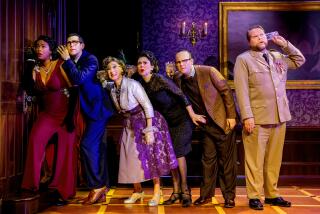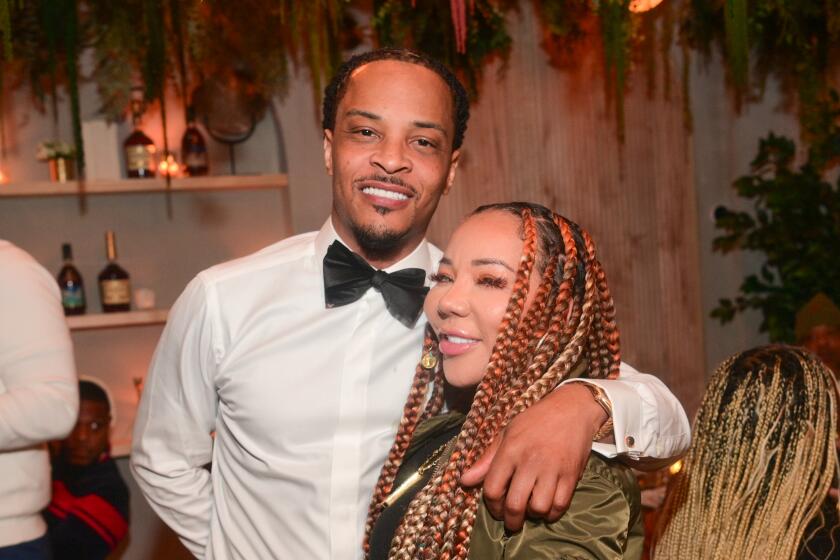Review: Before there was Photoshop, there was 19th century photographer Oscar Rejlander
Before there was Photoshop, there was Oscar G. Rejlander.
In fact, about 130 years before.
In 1857, the Swedish-born British artist cobbled together a slew of negatives to make one of the most vexed photographs of the 19th century. Titled “Two Ways of Life (Hope in Repentance),” the epic work is shown in two versions in “Oscar G. Rejlander: Artist Photographer,” a fascinating new exhibition at the J. Paul Getty Museum. Surprisingly, it’s the first full survey of the quirky artist’s work.
Prince Albert, an aficionado of the still relatively novel invention called a camera, liked “Two Ways of Life” so much that he acquired three prints in order to have one for each royal residence — Windsor, Osborne House and Balmoral. The photograph was certainly a technical feat. More than 30 negatives had been painstakingly merged to make the single large combination-print, which features an array of more than two dozen figures.
Not everyone was as enchanted as the prince. A critic for a journal in Edinburgh, Scotland, rebuked the complex picture for “stiffness and vulgarity.” Another decried it as “degraded.”
That was mostly because of all the female nudes. “Two Ways of Life” shows a lot of them, most prominently one seen from behind smack in the extreme foreground at the center. Repoussoir figures such as this one are commonly used in art to direct a viewer’s attention into a visually complicated scene. The contrast in scale also heightens an illusion of depth.
LACMA: Troublesome signs in a risky reorganization plan »
The hitch: A repoussoir figure is a kind of stand-in for the viewer, who is also peering into the scene. Rejlander’s use of a naked lady on the left-hand side made many observers gasp. Of the two ways of life being depicted, one full of virtue and the other filled with vice, her side features the wicked one. She is like the sirens of Greek mythology luring sailors to their shipwrecked doom on the rocky coast.
In a loose echo of “The School of Athens,” Raphael’s famous Renaissance fresco in the Vatican, a robed and bearded thinker is flanked by two young country lads. The sage is introducing his innocent charges to fateful choices available in the big city — scenes of upright piety such as prayer and ministering to the sick on the right, the debauchery of sloth, lust and gluttony on the left.
In this particular contest between virtue and vice, however, neither is especially compelling. Rejlander has composed an elaborate tableau vivant, something like the Pageant of the Masters in Laguna Beach, in which a troupe of players has been assembled to enact a work of art.
It looks like a lot of effort to make. In the Victorian England of Prince Albert, labor was highly valued — presuming you were not an aristocrat.
In class-bound Britain, maybe that distinction about labor had something to do with the noisy dustup Rejlander’s photograph inspired among the newly emerging community of photographers. It’s easy to see why the queen’s husband would admire the masterful handiwork of a fellow from “the lower orders” — an obviously productive immigrant making good as a British subject as the Industrial Revolution roared on. Yet photography was still so new and experimental that other lensmen were anxious about inclusion in public life among the fine-art ranks of painters and sculptors.
CHARLES WHITE: LACMA show pinpoints the power of an underappreciated black artist »
The show, ably organized by Lori Pauli, curator at the National Gallery of Canada, and Getty curator Karen Hellman is subtitled “Artist Photographer” to emphasize Rejlander’s primary aim. His fondest ambition was to secure a place for photographs as equal in importance to any other kind of art.
He began as a painter and continued to paint throughout his life. (Rejlander died in 1875 at age 61.) A few modest examples are on view, together with 150 photographic portraits, landscapes and allegorical subjects.
Like many converts to a new faith — he didn’t take up photography until he was nearly 40 — Rejlander was an adamant proselytizer. Conjoining negatives composed a photograph much the same way a painter combines drawings in composing a picture. (David Hockney is one artist whose recent work is a descendant.) Dressing up his wife, Mary, an accomplished actor, and other thespians was like using models in a painter’s studio.
Looking back, the kitschy “Two Ways of Life” is ironically less admirable than Rejlander’s portraits, which are among the show’s most compelling works. Some are as fine as any of the exquisitely honed portrait photographs of his friend Julia Margaret Cameron, a keen student of his expressive work.
In one, a young woman is seated next to a painted ancestral portrait. Both women are similarly attired, deftly linking the younger woman to her family’s past. However, just as important, Rejlander yoked a modern photograph to painting’s history.
In another, a young woman is shown in profile, arms folded across her chest. The inky velvet of her dress and the drapery behind her form a dark contrast to the soft light of her delicate features.
What’s unusual is that the composition is not centered on her face, which is positioned off to one side. Instead, the central focus is on the gently knotted twists of her upswept hair.
Those twists echo the intertwined hands, gently folded below. Marvelously composed, the subtle image emphasizes that the artistry of the hand supersedes a camera’s mechanical recording qualities.
ALLEN RUPPERSBERG: Hammer Museum show is a don’t-miss tour de force »
Many of Rejlander’s photographs carry a similar subtext, picturing his stance on the raging debates about whether or not camerawork could be art. A portrait of Mary and a self-portrait of the artist are exemplary.
Both show the sitters with a pet — a parrot emerging from a cage, its door wide open. The bird is a mimic, standing in for the camera’s capacity to “parrot” what’s in front of the lens. Nature and art possess the ability to repeat the reality before them.
Mary smiles at the bird in delight. As for Rejlander, in the self-portrait his head is bowed as if in deference, while his pencil is poised on a sketchpad. That the cage door is open seems to matter: A photograph can do more than merely record.
The negotiation between the new medium of photography and traditional forms of art is encapsulated in an odd work Rejlander made at the behest of evolutionary biologist Charles Darwin. The scientist was preparing an innovative study about facial recognition of emotions in humans and animals. Rejlander rounded up actors to perform a variety of demonstrative expressions that could illustrate Darwin’s pioneering text.
One was a very small picture of a crying baby — too small, in fact, to be published effectively. So Rejlander copied the little photograph as a larger drawing, and then photographed that.
Today, the argument between photography and art is long gone. But an evolutionary photograph of a drawing of a photograph is one clear indication of just how discombobulated the subject was at the very start.
♦ ♦ ♦ ♦ ♦ ♦ ♦ ♦ ♦ ♦
‘Oscar Rejlander: Artist Photographer’
Where: J. Paul Getty Museum, 1200 Getty Center Drive, Brentwood
When: Tuesdays-Sundays, through June 9
Admission: Free; parking is $15
Info: (310) 440-7300, www.getty.edu
More to Read
The biggest entertainment stories
Get our big stories about Hollywood, film, television, music, arts, culture and more right in your inbox as soon as they publish.
You may occasionally receive promotional content from the Los Angeles Times.











